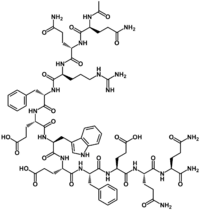Oligopeptide P11-4
P11-4 is a synthetic, pH controlled self-assembling peptide used for biomimetic mineralization e.g. for enamel regeneration[1] or as an oral care agent. P11-4 (INCI name Oligopeptide 104) consists of the natural occurring amino acids Glutamine, Glutamic acid, Phenylalanine, Tryptophan and Arginine.[2] The resulting higher molecular structure has a high affinity to tooth mineral.[3] P11-4 has been developed and patented by The University of Leeds (UK). The swiss company credentis has licensed the peptide technology and markets it under the trade names including CUROLOX, REGENAMEL, and EMOFLUOR. They offer three products with this technology.[4] As of June 2016 in Switzerland products are available with new Brand names from Dr. Wild & Co AG.[5]
 | |
| Names | |
|---|---|
Other names
| |
| Identifiers | |
3D model (JSmol) |
|
| ChemSpider | |
| |
| |
| Properties | |
| C72H98N20O22 | |
| Molar mass | 1595.694 g·mol−1 |
Except where otherwise noted, data are given for materials in their standard state (at 25 °C [77 °F], 100 kPa). | |
| Infobox references | |
Mechanism of action
P11-4 is an α-peptide that self-assembles into β-sheet amyloids with a hydrogel appearance at low pH.[6] It builds a 3-D bio-matrix with binding sites for calcium ions serving as nucleation point for hydroxyapatite (tooth mineral) formation. The high affinity to tooth mineral is based on matching distances of Ca-ion binding sites on P11-4 and Ca spacing in the crystal lattice of hydroxyapatite. The matrix formation is pH controlled and thus allows control matrix activity and place of formation.
P11-4 in dental applications
Self assembling properties of P11-4 are used to regenerate early caries lesions. By application of P11-4 on the tooth surface, the peptide diffuse through the intact hypomineralized plate into the early caries lesion body and start, due to the low pH in such a lesion, to self-assemble generating a peptide scaffold mimicking the enamel matrix. Around the newly formed matrix de-novo enamel-crystals are formed from calcium phosphate present in saliva. Through the remineralization caries activity is significantly reduced in comparison with a fluoride treatment alone.[7] In aqueous oral care gels the peptide is present as matrix. It binds directly as matrix to the tooth mineral and forms a stable layer on the teeth.[8] This layer does protect the teeth from acid attacks. It also occludes open dentin tubules and thus reduces the dental sensitivity.
Uses
- Treatment of initial caries lesions
- Regenerating enamel
- Dentin hypersensitivity
- Acid protection
Availability
Availability of products containing P11-4 vary by country, with some products available only to dentists, and others available to the retail public.
Medical device for caries treatment and enamel regeneration:
- CURODONT REPAIR (EU)
- REGENAMEL (CH)
Cosmetic products for acid protection and dentin desensitization:
- CURODONT PROTECT (EU)
- EMOFLUOR PROTECT GEL PROFESSIONAL (CH)
- CURODONT D’SENZ (EU & CH)
- EMOFLUOR DESENS GEL PROFESSIONAL (CH)
- Candida Protect Professional[9] (CH)
See also
- Amorphous calcium phosphate
- Remineralisation of teeth
- Oligopeptide
- Biomimetic materials
- Fluoride
- Recaldent
References
- Brunton, P.A.; Davies, R.P.W. (2 July 2013). "Treatment of early caries lesions using biomimetic self-assembling-peptides – a clinical safety trial". Br Dent J. 215 (E6): E6. doi:10.1038/sj.bdj.2013.741. PMC 3813405. PMID 23969679.
- "European Commission database with information on cosmetic substances and ingredients". Oligopeptide 104. Retrieved 1 July 2015.
- Kirkham, J; et al. (May 2007). "Self-assembling Peptide Scaffolds Promote Enamel Remineralization". J Dent Res. 86 (5): 426–430. doi:10.1177/154405910708600507. PMID 17452562.
- "credentis webpage". Retrieved 1 July 2015.
- AG, Touch Design. "Credentis: credentis ag and Dr. Wild & Co. AG strengthen their successful partnership". www.credentis.com. Retrieved 2016-06-29.
- Aggeli, A; Bell, M; et al. (20 March 1997). "Responsive gels formed by the spontaneous self-assembly of peptides into polymeric β-sheet tapes". Nature. 386 (6622): 259–262. doi:10.1038/386259a0. PMID 9069283.
- Alkilzy, M; et al. (May 15, 2015). "Efficacy, Clinical Applicability and Safety, of CurodontTM Repair in Children with Early Occlusal Caries". Caries Res. 49: 311. doi:10.1159/000381323.
- Chen, X; et al. (Sep 2014). "Dentine Tubule Occlusion of a Novel Self-n Vitro Evaluation of Dentine Remineralisation by a Self-Assembling Peptide Using Scanning Electron Microscopy". Caries Res. 48: 402. doi:10.1159/000360836. Retrieved 1 July 2015.
- "Candida Zahnpasta Protect Professional". Retrieved 1 July 2015.